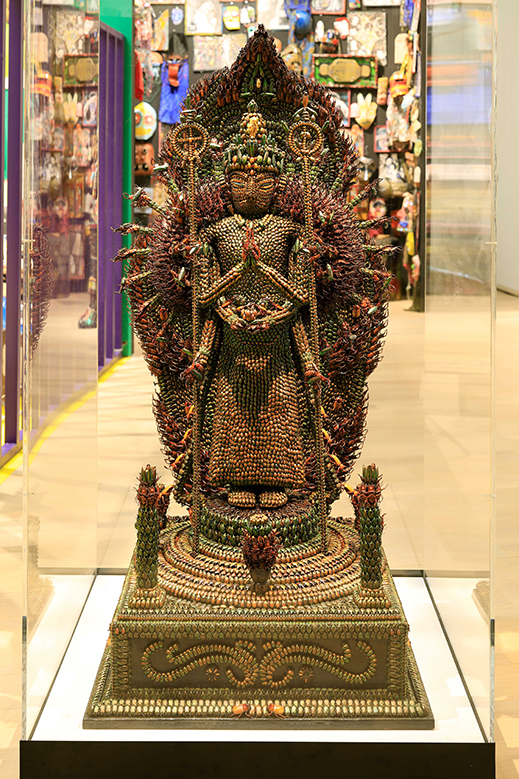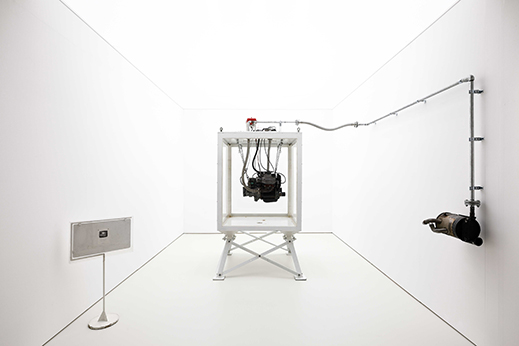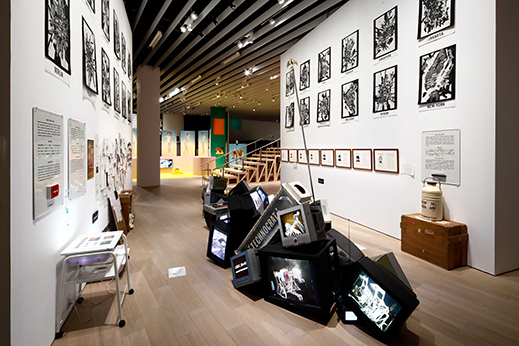 |
Focus features two in-depth reviews each month of fine art, architecture, and design exhibitions at art museums, galleries, and alternative spaces around Japan. |
|
|
 |
 |
 |
Lost in Space: A Stroll through the Heisei Debris
Colin Smith |
 |
Masayuki Towata + Yasuaki Matsumoto, Divina Commedia, 1991, documents an underground event at Kobe's Xebec Hall. |
The Heisei era (1989-2019) ended just two years ago, but of course the past year-plus has turned 2019 into dimly remembered history, and it doesn't feel like too soon to look back at the era that was. This is what Bubbles/Debris: Art of the Heisei Period, an exhibition at the Kyoto City Kyocera Museum of Art, endeavors to do. Heisei, like the current Reiwa and the earlier Meiji, Taisho, and Showa, refers to the reign of an emperor, in this case Emperor Akihito. Marking history by monarchs' reigns isn't unique to Japan (Victorian? Edwardian?) and no more artificial than talking about "the eighties" or any other decade -- but why Heisei now?
The show's curator, the influential art critic Noi Sawaragi, explains that the title references two books separated by many centuries. "Bubbles" is from the 13th-century Hojoki ("The Ten-Foot Square Hut") by the ascetic monk Kamo no Chomei, who reflected on impermanence -- all too evident in the fires, famines, earthquakes and conflicts of his day -- with the famous metaphor of a river always flowing but never the same, bubbles forming on its surface and vanishing in an instant. "Debris" is from a 2019 book by the architect Arata Isozaki on the future of cities and civilization in crisis. As the Heisei era dawned, Japan was still afloat on the economic "bubble" of the roaring eighties; as it ended, the country was still cleaning up after the 2011 Tohoku earthquake, tsunami and nuclear disaster. Both euphoria and nihilism flavor this (intentionally) chaotic and overwhelming show, which begins with the 15-meter-long, floor-to-ceiling Heisei Wall designed by Gento Matsumoto, a blackboard with newspaper front pages from the 1989 fall of the Berlin Wall to the 2019 coronation of the current emperor, ringed by masses of handwritten text and archival printed matter.
|
 |
|
|
|
Yoneji Imamura, Insect Thousand-Armed Kannon, 1975. Twenty thousand beetles, one bodhisattva -- it predates Heisei but fits in with the era's, and the show's, over-the-top aesthetic.
|
You then enter a densely packed arena of works that nearly all brim with youthful energy, though a highlight of the show, Yoneji Imamura's statue Insect Thousand-Armed Kannon (1975), was made with 20,000 beetles when the artist was in his mid-fifties and it was still the Showa era -- more on that later. The exhibition is organized around artist groups (14 in all) rather than individuals, although "Kokufu Osamu's Engine in the Water Re-creation Project" stands out as an effort to replicate an ominous sculpture by a single artist, who tragically died while working on his machinery- and vehicle-centered art. There are none of the usual "Route" signs pointing which way to go, and it is advisable to pace yourself -- there's no way to look at every drawing, read every text, and watch every video all the way through. It's well worth waiting for timed entry to the room showing the grainy, intense 15-minute video Divina Commedia (1991), documenting an installation/happening by Masayuki Towata and Yasuaki Matsumoto in which five test subjects wore dustproof suits and floated face up on a giant pool of blue gel amid flashing lights and ambient noise, sensory overload and sensory deprivation combining to return them to the womb. This early-Heisei work evokes the anxieties of the time (HIV, the coming cyber-future), and eerily presages late-Heisei radiation-suited cleanup workers and post-Heisei PPE-clad medical personnel. One might also recall the 1997 incident in which a Pokemon episode with rapidly strobing lights caused widespread, unexpected convulsive reactions, but apparently this flashing carries no such risks.
 |
|
"Kokufu Osamu's Engine in the Water Re-creation Project." Kokufu died working with his favorite material, the automobile; here the sound of water, which ought to fill the tank, reminds us of his absence.
|
Speaking of Pokemon, the collective Chim↑Pom has been engaged since 2006 in its Super Rat project, capturing rats on Tokyo streets with fishing nets, stuffing them and painting them stripy-yellow to resemble the anime's flagship character Pikachu. The rats are then placed in dioramas, in this case looming like Godzilla over a decimated urban landscape alongside a video of the intricate miniature cityscape being destroyed. Here the group juxtaposes the diorama with this exhibition's most literal manifestation of debris, Building-Burgers, made by stacking layers of garbage and sawed-out concrete floor following a demolition in which the members took part (for more details, see Here and There, "Rumble in the Rubble: Chim↑Pom at Anomaly"). In the capital, the frequent collapse of buildings is (so far) the result of frenzied redevelopment, exacerbated by the coming(?) summer Olympics, rather than natural disasters or super-sized creatures, as per the subtitle of one Super Rat installation shown here: Scrap & Build.
 |
|
Chim↑Pom, Building-Burgers and Super Rat: Scrap & Build, 2018. Beyond the debris, a dyed rat or two and a mini-diorama are visible.
|
Also on a creepy-crawly note, the beetle bodhisattva mentioned earlier looks like the result of years of loving labor, and like what it is: outsider art (also known as Art Brut) and -- not to belabor the point -- the work of a generation with much longer attention spans. It is included not because it dates from the Heisei era but because it is in a section on Kushino Terrace, an art space in Fukuyama, Hiroshima launched in 2016 by Nobumasa Kushino. Formerly a curator at the very worthwhile, outsider-oriented Tomonotsu Museum, also in Fukuyama, Kushino claims the title of "Japan's only outsider curator." Looking beyond the too-common view of outsider art as by people with mental disabilities, he organizes exhibitions of work by prison inmates, representations of the yankii subculture, and at this show a wall of lovingly detailed, same-but-different drawings of rags by janitor Gataro, who appears in a video discussing this monastic practice of many years. There is also an area filled floor-to-ceiling with some of the 20,000 bricolage masks made by an anonymous creator who, in a strange twist, claimed to be a solitary newspaper deliveryman living with 20 stray cats (a typical outsider story), but after his death was found to be more of a conventional family man.
Though the show has no designated route, the Kushino Terrace exhibit is probably where most visitors will end up, and by this point they may be exhausted. A thoroughly documented and annotated trip through three decades of provocative collective art projects could not end otherwise, even in the delightfully spacious Higashiyama Cube, the new wing of the expanded and rebranded Kyoto City Kyocera Museum of Art. If you find yourself asking, "What was that all about?" you may have gotten the point of the show, the Heisei era, art history, and heck, history itself.
 |
|
Chaos reigns: Technocrat, Dutch Lives, 2020. Instructions on the floor specify (one assumes ironically) that women should pass on one side and men on the other, but during a recent visit this was being ignored.
|
All photos by Keizo Kioku, courtesy of the Kyoto City Kyocera Museum of Art.
|
 |
 |
Colin Smith
Colin Smith is a translator and writer and a long-term resident of Osaka. His published writing includes the travel guide Getting Around Kyoto and Nara (Tuttle, 2015), and his translations, primarily on Japanese art, have appeared in From Postwar to Postmodern: Art in Japan 1945-1989: Primary Documents (MoMA Primary Documents, 2012) and many museum and gallery publications in Japan. |
|
 |
|